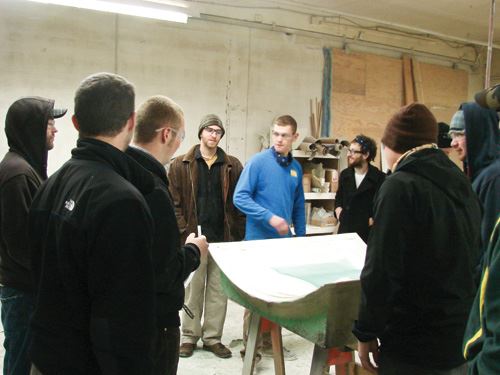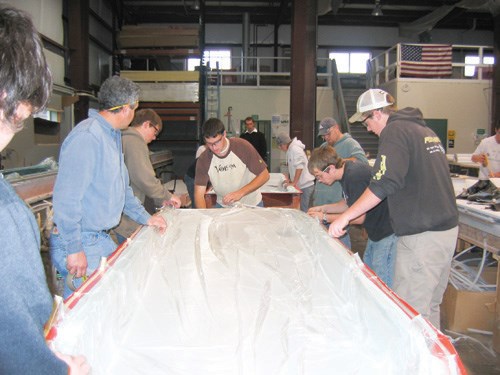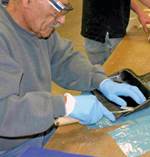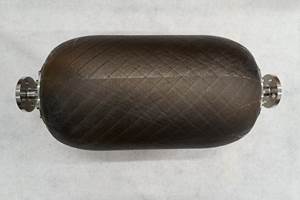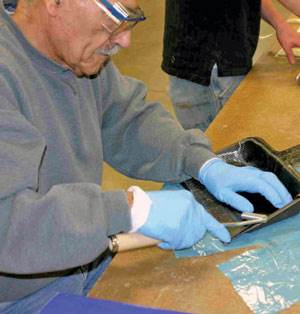Training surge: Too little, too late?
Hands-on programs are aimed at younger students by educators hoping to prevent shortages of composites technicians and engineers.
Remember wood shop, metal shop and drafting classes when you were in school? A lucky few may recall building a surfboard in composites shop. In the U.S., hands-on vocational or engineering training classes are a distant memory in most publicly financed middle and high schools; they are victims of shrinking budgets, teacher cutbacks and a narrow focus on four-year university preparation. As vocational training disappears, the STEM pipeline — science, technology, engineering and math — is constricted. Fewer students are expressing interest in a technical manufacturing career. Worse, this lack of interest comes at a time when America’s “baby boomer” generation is starting to retire.
Jim Albaugh, president of The Boeing Co.’s (Chicago, Ill.) Boeing Commercial Airplanes division, told the Everett, Wash.-based HeraldNet (May 23, 2010) that retirements from the technical workforce amount to “the intellectual disarmament” of the U.S. And there are too few people to take the place of retirees. “We don’t have enough young people getting interested in math and science,” he warns.
It’s a worrisome situation for many observers, who say that the U.S. education system has failed to provide crucial trades training to help America maintain global competitiveness. “Secondary and high schools, and even colleges, have migrated away from technical training, which has resulted in a new generation of young people who have no basic marketable skills,” reports one composites educator, Ray Elledge, program manager at the California Manufacturing Technology Consulting (CMTC) group, a U.S. Department of Commerce Hollings Manufacturing Extension Center and a strategic partner with Cerritos College (Norwalk, Calif.). Elledge says, “Unfortunately, technology training programs are too expensive for most schools.”
Bill Kreysler, president of Kreysler & Assoc. (American Canyon, Calif.), points to unrealistic cultural expectations. “Not every kid needs a college degree,” he contends. “We really need to change the mind-set that you’re a second-class citizen if you don’t go to college. Our society needs to embrace the idea that there’s honor in mastering a trade.” Indeed, according to “Made in America: What the Public Thinks About Manufacturing Today,” a report by market research firm Deloitte (New York, N.Y.), nearly 80 percent of respondents to a recent survey indicated they believe manufacturing is important to the future of, and standard of living in, the U.S., yet respondents ranked manufacturing nearly at the bottom of a careers preference list. Prepared for the National Association of Manufacturers’ (NAM) education arm, the Manufacturing Institute (Washington, D.C.), the Deloitte document underscored that, at the height of the recent recession, an estimated 80 percent of U.S. manufacturers reported a moderate to serious shortage of qualified job applicants.
The composites industry is no stranger to such shortages. CT has reported this lack and covered remedial training and education efforts in some detail in the past (see “The state of ...." articles and "The future of ...." under "Editor's Picks," at top right), with emphasis on college-level and adult training. But Jim Hatch, advanced composites instructor at Ogden-Weber Applied Technology College (Ogden, Utah), who is actively involved in many training initiatives, points out that the “industry is desperate for any type of training that produces competent technicians — we can’t turn out enough students to meet the workforce needs in our part of the country.” The corrective? Elledge argues that attention needs to return to secondary and high schools, where “academic, college-track courses … aren’t always relevant for students who want to become part of the production workforce.”
Taking the initiative
Fortunately, progress is being made on several fronts, both nationally and locally. A number of technical training schools and community colleges that offer composites training are reaching out to younger students in their area. This includes not only training courses, but also job shadowing and familiarization opportunities. The International Yacht Restoration School (IYRS, Newport, R.I.), for example, offers exposure programs to high school students. These programs demonstrate the opportunities available in boatbuilding, says IYRS’s Clark Poston. Similarly, NAM’s Manufacturing Institute is encouraging young people to choose manufacturing careers with its national Dream It. Do It. program. And some key companies in the composites industry are attempting to engage and energize new workers early.
Miles Fiberglass & Composites (MFC, Portland, Ore.), for one, has supported local schools for years. The company “adopted” a nearby grade-school class, providing monetary donations and guided tours of the company’s facility, says MFC president Lori Luchak. “We give the little kids a tour when we’re building some interesting things.” She is also on the advisory board of the Sabin-Schellenberg Professional Technical Center, a local vocational and technical training school. Through Luchak’s efforts, the technical school has become MFC’s training partner, offering classes in composites fabrication to students. “We’ve provided internships and job shadowing,” she reports, “where students follow our workers to learn about composites as part of a senior project.”
MFC also hired a teacher from Sabin-Schellenberg for several summers. Mark Lynch, from the school’s manufacturing and engineering department, worked in various positions at MFC to learn as much as possible about composites and pass that knowledge along to students. Luchak reports that Lynch’s experience enabled him to teach a semester-long class on fabrication of a carbon/epoxy skateboard. Materials were donated by MFC and Owens Corning (Toledo, Ohio), and a chopper gun was donated by Valspar Composites (Elkhart, Ind.). Then, in 2006, his students built a 1932 roadster body, using MFC’s facilities. Afterward, students showed the car at the Portland Hot Rod Show and sold it to defray class expenses.
Luchak is also president-elect and serves as a director of the American Composites Manufacturers Assn. (ACMA, Arlington, Va.) and is active in that organization’s efforts to foster more composites education in schools. While her company’s efforts have required a significant monetary commitment, she reports that it has paid dividends — MFC has been able to hire several of Sabin-Schellenberg’s graduates to replace retiring workers. “Partnering with your local community college or high school and helping them to establish training programs is a win-win situation,” she contends, “since you are creating a skilled talent pool for hiring.”
On the East Coast, Foster Technology Center (Farmington, Maine), one of more than two dozen vocational high schools under the State of Maine’s Career and Technical Education (CTE) umbrella, offers composites classes taught by John MacDonald. An educator with more than 30 years of experience, he advocates a “hands-on, minds-on” approach. “Over the years, I have included composites in my materials technology units, and very often my pre-engineering students employ composites to solve technical challenges posed to them.”
Some of those challenges have included participation in popular Electrathon competitions. Sanctioned by a national nonprofit governing body, these events challenge participating teams to design and build three- or four-wheeled, single-person electric vehicles. Says MacDonald, “Electrathon involves innovation, imagination and focus on energy efficiency — a perfect use of composites!” His students have developed progressively more sophisticated vehicles over the years, including a resin-infused, aerodynamic carbon monocoque that weighed only 83 lb/37.7 kg, without batteries. Along the way, he reports, students have applied math, science, chemistry, drafting and other skills — winning three national Electrathon championships for their efforts.
More recently, MacDonald was tasked with creating a vocational composites curriculum at Foster. He partnered with the Maine Advanced Technology Center (MATC), a composites training initiative undertaken on Southern Maine Community College’s Brunswick campus that was made possible by a community-based job training grant. MacDonald took courses at the center to enhance his own knowledge, while taking advantage of the networking opportunities the center provided. “The supportive people I met helped us build a very strong program for the Foster students, which continues to receive great community support and recognition,” he says.
Foster recently was in the spotlight as one of 18 Maine high schools and vocational centers that took part in the 2010 Maine High School Wind Blade Challenge, a program that will be held again in 2011 (see "Students tackle ...." under “Editor's Picks”). The challenge, sponsored by the Maine North Star Alliance Initiative and the Maine Composites Alliance, asked 31 teams to design the most efficient wind blade (18 inches/457 mm long and a swept area 42 inches/1,067 mm in diameter) using a kit of composite resources provided by Harbor Technologies Inc. and OCV Technical Fabrics, both of Brunswick. Students researched wind blade design and performance and, with help from six composites manufacturing facilities, vacuum infused their blades. Those facilities, all in Maine, included Foster, MATC, The Landing School (Arundel), Husson Boat School (Eastport), Custom Composite Technologies (Bath) and Kenway Corp. (Augusta).
The Advanced Engineered Wood and Composite Center (AEWC) at the University of Maine (Orono, Maine) created a universal testing hub on which the blades were mounted for official testing. MacDonald notes that AEWC director “Dr. Habib Dagher has arranged for the 2011 blade contest winners to receive work-study scholarships at the university, which is a great opportunity for our students.” He adds that a growing number of Maine’s vocational high schools are initiating composites programs and that more composites companies are mentoring and partnering with those schools and providing job shadowing opportunities. “Composites open up a whole world for kids who want to design and build interesting parts — kids are excited when they see the application of their academic studies,” he concludes.
Educational outreach
“We see tremendous opportunities for delivering composites education,” says Tom Dobbins, ACMA’s chief staff executive. The trade group established its Certified Composite Technician (CCT) program 12 years ago, targeted to workers within its member company base. Since then, more than 4,000 workers have gone through the program and 1,623 are currently certified. Now, says Dobbins, the group is pushing the CCT program outward and working to partner with its 22 academic members, which include community colleges, vocational schools and, in some cases, high schools. “We’re looking for more schools to join the ACMA network,” states Dobbins.
Notable examples of ACMA’s CCT program in academic settings include the previously mentioned MATC, whose students can take a wide range of courses, including open molding and resin infusion, then complete the CCT certification course requirements and take the certification test at MATC. “The CCT certification acts as credits earned for students who want to go further in their studies at Southern Maine Community College’s Brunswick campus,” Dobbins points out. Similar CCT training also is offered at Husson Boat School.
Outside Maine, Dobbins cites Clackamas Community College (Oregon City, Ore.) as another composites education success story. The school offers a curriculum for wind energy composites technicians, with grant-based scholarships available. Students learn to fabricate and repair wind turbine blades. At the end of the program, they also earn CCT certification in Open Molding, Vacuum Infusion Process (VIP) and Wind Blade Repair (WBR). The program is supported, in part, by MFC, and Luchak reports that an MFC employee helped to develop the curriculum and now teaches some of the classes at the Clackamas campus.
Other for-profit schools that offer CCT training include NEW TEC Inc. (Aberdeen, S.D.), which offers classes in wind blade fabrication methods. NEW TEC graduates receive their CCT certificate, and after graduation, they are typically placed into technical employment at Molded Fiber Glass South Dakota (Aberdeen, S.D.), which produces wind turbine blades. Tulsa Technology Center, a Tulsa, Okla.-based technical school, also offers CCT training. “These are all customized programs that were developed by looking at the local markets and employers, as well as working with the school itself,” says Dobbins.
ACMA started reaching out to younger students several years ago when it initiated the Think Composites program for high school students. Led by Owens Corning, Think Composites sought to expose students from local high schools to the industry in the cities where the group’s annual convention was located. During the 2006 convention held in St. Louis, Mo., the group brought 50 to 60 high school students to the exhibit hall, provided an orientation on composites — several videos, PowerPoint presentations and stand-up briefs by staff — then took them on a tour of the exhibits and live demonstrations. The goal was to introduce students to possible mentors, such as area employers in the business, and provide them with resources to pursue science fair projects using composite materials.
ACMA’s Caitlin Felker, manager of conferences and education, explains, “It’s critical to the growth of the composites industry to provide as much exposure as possible to the next generation of engineers, architects, entrepreneurs, artists and technicians who will perpetuate our industry.”
This desire was the impetus for ACMA’s Boy Scout Merit Badge program. The Composites Merit Badge, first awarded in 2006 as part of Think Composites and sponsored in part by M.C. Gill Corp. (El Monte, Calif.), allows ACMA to disseminate basic composites knowledge to Boy Scouts and, by association, a new generation of young people. With guidance provided by ACMA (available on the group’s Web site at www.acmanet.org/bsa/index.cfm), scouts earn the badge by learning a considerable amount about the industry and building a part, such as a hiking stick, skateboard or modified pinewood derby car. The badge requirements include visiting a composites company, if possible, which introduces the scout to a real-world facility environment — and potentially, future job opportunities. At the 2010 Boy Scout Jamboree, so many scouts turned up to make a composite hiking stick and earn their badge that many had to be turned away. To date, almost 5,000 Boy Scouts have received the Composites Merit Badge, says Felker. “This program has been such a success,” she says, “that it is the main focus of our youth education.”
“We realize that the composites industry is evolving rapidly and we’re evaluating how to stay ahead of the curve with regards to delivering education,” declares Dobbins. He reveals that ACMA plans to roll out Web-based educational modules that will be appropriate for students of any age interested in composites training. Nine existing CCT modules were recently supplemented with two new modules: Wind Blade Repair and Light Resin Transfer Molding. Others, targeted to experienced composite industry workers, are planned as well. Offering CCTs in multiple languages is also under consideration. Adds Dobbins, “The Web allows us to transcend boundaries, and we can become an international resource for composites expertise.”
Hatch of Ogden-Weber is an active champion for high-school age composites training. “Education has been very, very slow in providing the vocational training for composites technicians,” he says, explaining that Ogden-Weber, one of four colleges in Utah that offers composites training, is based on a “competency-based” model different from that used by most U.S. high schools, colleges and universities. Students begin their individual studies immediately upon enrollment, and they graduate when they have mastered the required skills, independent of calendar dates. Twenty-five percent of the students at the college are high school students, usually seniors who have otherwise fulfilled their graduation requirements. “High schoolers go through the same composites training courses as the adults, and they do not have to pay tuition,” he adds. Funding comes from a number of sources, including the Utah Centennial Opportunity Program in Education (UCOPE). Hatch is a strong believer in hands-on training, especially for composites, and stresses that the bulk of the Ogden-Weber training is just that: primarily lab work with relatively little traditional classroom time.
Ogden-Weber regularly opens its doors to local middle and high schools, as well as the Boy Scouts involved in ACMA’s Composites Merit Badge program. Hatch and colleagues visit area high schools once a year and give talks about composites to recruit students for training. He is currently developing an apprenticeship program for composites that has the potential to be a national model for schools and industry to follow, with an emphasis on composites repair techniques. “This is a big deal,” he insists. “We really need to be teaching courses like material science in our high schools. When students get their hands on the materials, they love it.”
Presenting opportunities
Elledge recollects a class at Cerritos College in which invited high school students were given a block of modeling clay and asked to create something — a unique shape or part. Then the clay objects were digitized and the data were fed into a CAD model, which translated the part dimensions to machine language for a cutting machine. High-density foam parts were then machined by a CNC cutter. Students developed the design, participated in the process, kept the finished products and thoroughly enjoyed the experience, says Elledge. “It was a unique way to expose kids to technology and encourage their creativity, and show them how it can be translated to the real world.”
But, he relates, this type of short-term event requires funding that is, unfortunately, in short supply for community colleges: “Training for technology and work in the trades has always been an important part of the community college mission, but delivery has been severely impacted by budget problems.” He points out that the pace of class curriculum development is often slower than the evolution of the technology. Consequently, the schools are playing catch-up — something that can be alleviated by more partnerships with industry.
Elledge reports that his CMTC consulting group is able to procure training funds from the U.S. Department of Commerce via the Manufacturing Extension Partnership (MEP) program. CMTC also has access to California Employment Training Panel funding that supports manufacturers that provide training. (Manufacturers can qualify for funding under CMTC’s multi-employer contract with the state.) “Politicians now realize that manufacturing is the foundation of our economy,” Elledge reports. “But to keep a skilled workforce, we need training to be passed down to maintain our global competitiveness. Losing that training really hurts commodity businesses.”
Dream It. Do It. is a national manufacturing careers recruitment strategy, says Jacey Wilkins, senior associate director of communications for the Manufacturing Institute. But its real impact reportedly is local. States, regions or counties deploy customized programs to engage local students, and manufacturers are provided with materials, ideas and national exposure. Wilkins cites unique examples from the program’s 21 regions, such as Nebraska’s Dream It. Do It. manufacturing Career Dream Team or Indiana’s social media campaign. The effort “spans every level of education and career navigation, from elementary school through high school and college,” she notes. “In some cases, the campaign targets transitioning workers or individuals looking to advance in their careers. In many sites, manufacturers actually go into elementary schools to explain how things are made and start to familiarize students with manufacturing.”
The Manufacturing Institute currently deploys the NAM-endorsed Manufacturing Skills Certification System, which gives individuals access to the skills and competencies they need to succeed in today’s advanced manufacturing economy, including composites. “There’s a potential shortage of 3 million skilled workers looming,” warns Wilkins. “This is an incredibly urgent need. The ability of manufacturers to be competitive in the global economy depends on their capacity for innovation. The biggest innovation driver is a highly skilled and educated workforce.”
For more information about “Dream It. Do It," visit http://institute.nam.org/view/4011005070822629971/info.
Related Content
NCC reaches milestone in composite cryogenic hydrogen program
The National Composites Centre is testing composite cryogenic storage tank demonstrators with increasing complexity, to support U.K. transition to the hydrogen economy.
Read MoreUpdate: THOR project for industrialized, recyclable thermoplastic composite tanks for hydrogen storage
A look into the tape/liner materials, LATW/recycling processes, design software and new equipment toward commercialization of Type 4.5 tanks.
Read MoreComposites end markets: Energy (2024)
Composites are used widely in oil/gas, wind and other renewable energy applications. Despite market challenges, growth potential and innovation for composites continue.
Read MoreDrag-based wind turbine design for higher energy capture
Claiming significantly higher power generation capacity than traditional blades, Xenecore aims to scale up its current monocoque, fan-shaped wind blades, made via compression molded carbon fiber/epoxy with I-beam ribs and microsphere structural foam.
Read MoreRead Next
Education: Retooling Theory and Practice
To meet the critical need for knowledgeable composites engineers and technicians, public/private partnerships are molding new applications-driven and transportable educational methods.
Read MoreVIDEO: High-volume processing for fiberglass components
Cannon Ergos, a company specializing in high-ton presses and equipment for composites fabrication and plastics processing, displayed automotive and industrial components at CAMX 2024.
Read More

